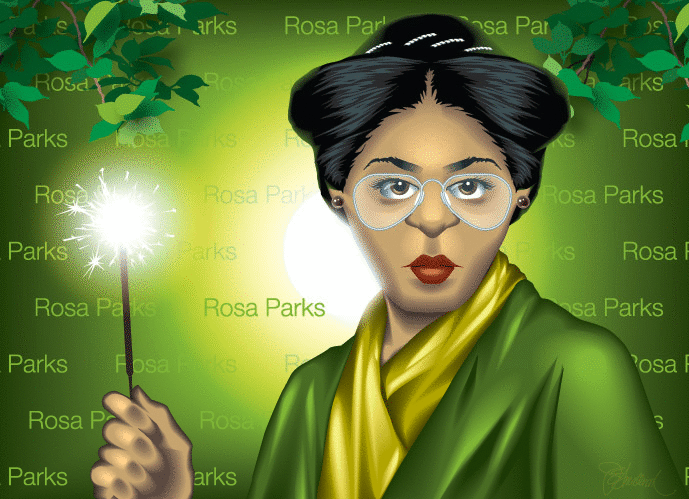
“I was not tired physically.
No, the only tired I was,
was tired of giving in.”
|
|
|
 Rosa Parks Rosa Parks
(1913-2005) — The First Lady of the Civil Rights Movement
By Bob Hilson
On Dec. 1, 1955, after a long day at work as a seamstress, Rosa Parks quietly took a seat in the “colored” section of a Montgomery, Ala., transit bus to go home. As the bus travelled, it began to fill with white passengers. Soon, the bus driver approached Parks and told her that the “whites only” had reached its capacity and she would have to give her seat to a white rider.
Bus segregation was unconstitutional
Within minutes, Parks, 42, was arrested and taken to jail, where she was fingerprinted, booked and detained briefly. Four days later, outraged blacks in Montgomery began a 381-day boycott of all transit buses that ended when the Supreme Court ruled that bus segregation was unconstitutional.
Parks’ peaceful act of defiance is believed to have ignited the Civil Rights Movement. But Parks said her act was not to spark protests or to become a player in the struggle for racial equality.
“People always say that I didn’t give up my seat because I was tired, but that isn’t true,” she said. “I was not tired physically. No, the only tired I was, was tired of giving in.”
Parks’ refusal not only triggered the Montgomery transit bus boycott, but led to nationwide efforts to end segregation in public facilities. Her arrest also led to the emergence of Rev. Martin Luther King Jr., a little known minister who led the well-coordinated and peaceful bus boycott.
“Mrs. Rosa Parks is a fine person,” King said at a church congregation four days after her arrest. “And, since it had to happen, I’m happy that it happened to a person like Mrs. Parks, for nobody can doubt the boundless outreach of her integrity.”
“Nobody can doubt the height of her character. And I'm happy since it had to happen, it happened to a person that nobody can call a disturbing factor in the community.”
Born Rosa Louise McCauley in Tuskegee, Ala. in 1913, Parks’ mother moved the family to Pine Level, Ala., to live with her parents, both former slaves and strong advocates for racial equality.
Parks attended a segregated, one-room, first through sixth grade schoolhouse that lacked essential supplies, including desks. Parks and other black Pine Level youngsters walked to school, while the city provided bus transportation and better learning facilities for white students.
In 1932, she married Raymond Parks, a barber and active member of the National Association for the Advancement of Colored People. She soon became active with both the Montgomery chapter and national NAACP. She had no children.
Labeled by the U.S. Congress as the “First Lady of Civil Rights,” Parks received countless honors throughout her life and posthumously. 1996, she was awarded the Presidential Medal of Freedom by President Bill Clinton, the highest honor given by the United States’ executive branch. Three years later, Time magazine named Parks one of the “20 most influential people of the 20th Century.”

When she died, Parks was the first woman and third non-U.S. government official to lie in honor at the U.S. Capitol Rotunda. She was buried in Detroit.
|











